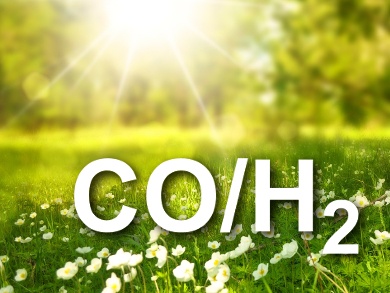Catalysts for CO2 Fixation
Artificial photosynthesis, like plant photosynthesis, seeks to turn sunlight energy into reduction equivalents to be used as a fuel source or for synthesis. Jun Song, McGill University, Montreal, Canada, Zetian Mi, McGill University and University of Michigan, Ann Arbor, USA, and colleagues have achieved a direct photocatalytic production of syngas, an industrially relevant mixture comprising carbon monoxide and hydrogen. They designed a nanostructured photocathode that provides the metal–metal oxide interface to activate and reduce CO2 from a saturated solution with water protons.
Fishing CO2 from the air and converting it into useful chemicals is usually the domain of plant photosynthesis. Photosynthetically active organisms convert light into reduction equivalents by an enzymatic reaction sequence known as water splitting or “light reaction” and then, in a subsequent “dark reaction”, they reduce the CO2 from the air into sugars. In artificial photosynthesis, the two reactions, water splitting and CO2 fixation, are mostly treated as separate technologies, as well. Semiconductor photocathodes are used to harvest sunlight and release electrons, which then combine with protons from water to form hydrogen gas. This process needs catalysis. Especially designed catalysts are also required for the electrochemical CO2 reduction, the “dark reaction”.
Syngas Production by Photosynthesis
The first reduction product of CO2 is carbon monoxide. A mix of carbon monoxide and hydrogen is syngas or synthesis gas, which is an industrial feedstock for the synthesis of basic chemicals and synthetic petroleum. It also serves as a prominent fuel source. Syngas is usually produced by the gasification of a carbon-containing fuel such as coke or coal emissions. The researchers have found a way to obtain syngas as a gaseous product directly from the reductive half-reaction of the water-splitting photocatalytic reaction. The trick was to identify the catalytic conditions to promote CO2 conversion besides proton reduction.
As a suitable catalyst, the scientists proposed a combination of noble metal and metal oxide, the interplay of which would provide the right electronic and spatial environment to weaken the strong carbon–oxygen bonds. They designed a photoelectrode using platinum nanoparticles and an ultrathin layer of titanium dioxide as catalyst and co-catalyst, both deposited on the surface of an array of gallium nitride nanowires grown on a silicon substrate.
A Turn at the Interface
In this morphology, the silicon substrate would absorb light and provide the energy for electron conduction through the nanowires, while the molecular contact of the platinum metal and titanium dioxide structure would form the catalytic sites for CO2 activation. Backed up by theoretical calculations, the team proposed a bent structure of the CO2 molecule at the metal–oxide interface, finally leading to electron uptake and oxygen loss to give the carbon monoxide product.
The experimental outcome was a remarkably efficient syngas production at low electrode potentials. Another aspect, as the scientists pointed out, was the tunable ratio of carbon monoxide and hydrogen. The photoelectrochemical syngas production highlights the potential of artificial photosynthesis to obtain useful basic chemicals in one step. Further studies will focus on the catalyst design for more efficient and selective CO2 reduction, the team stated.
- Photoelectrochemical CO2 Reduction into Syngas with the Metal/Oxide Interface,
Sheng Chu, Pengfei Ou, Pegah Ghamari, Srinivas Vanka, Baowen Zhou, Ishiang Shih, Jun Song, Zetian Mi,
J. Am. Chem. Soc. 2018.
https://doi.org/10.1021/jacs.8b03067



